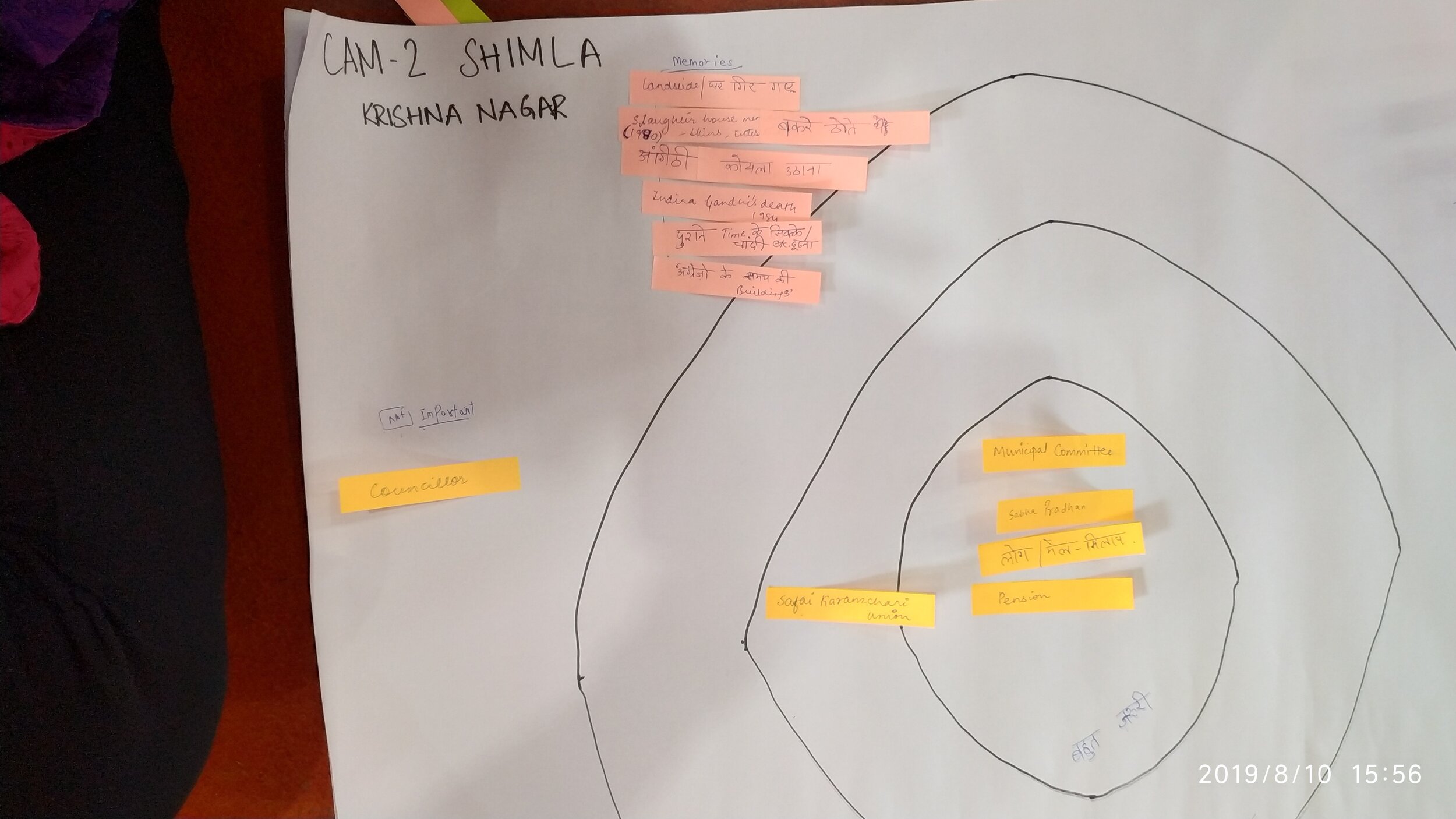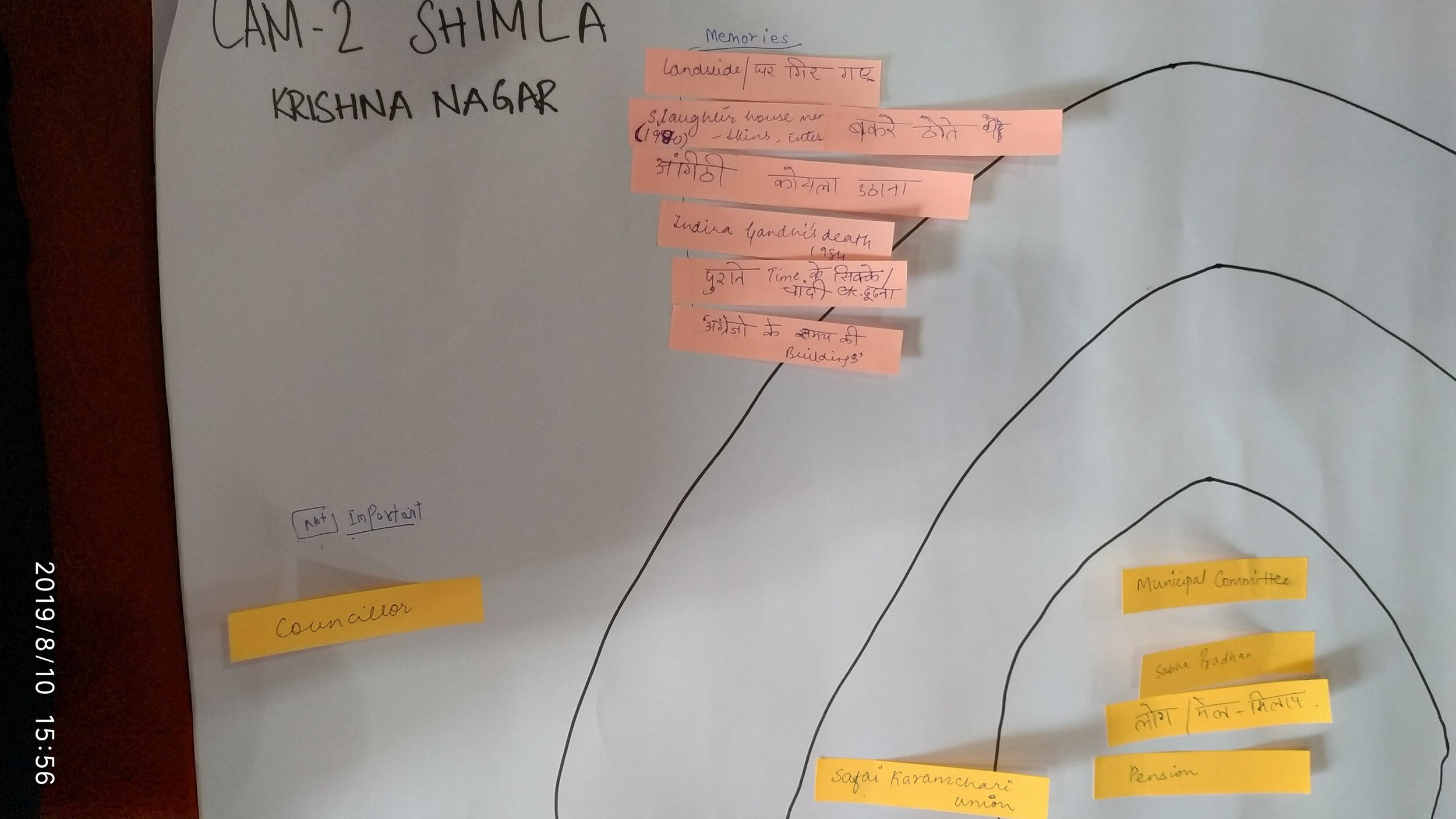Shimla Krishna Nagar Community Asset Mapping Workshop
On August 10, 2019 members of the research team met with a group of residents of the Krishna Nagar area in Shimla to conduct a Community Asset Mapping (CAM) Workshop. Besides the usual tools and methods that were being used in the previous CAM workshops, this exercise had the added goal of understanding the built environment of the selected area and placing archival data in conversation with the collective memory of the community.
One of the first issues the discussions addressed was to trace the shifting location of the slaughterhouse that marks the edges of the neighbourhood. Documents in the municipal archive mentioned different locations for this landmark structure at different points of time. The participants recounted how the old slaughterhouse was situated below Cart Road, near the stairs leading up to the Gurdwara. The meat workers (from the Dalit community) lived in a settlement around the Masjid at the end of the road. This was eventually destroyed, and a park was constructed in its place. A slaughterhouse was later reconstructed further away from the city centre. At present the slaughterhouse stands close to the by-pass road downhill from Cart Road. None of the participants could recall any residents or their ancestors having access to maps or historical photographs of the area. This made evident the lack of formalized representations and knowledges around marginal parts of the city.
The discussion eventually turned to the smart city projects. The participants reported that none of the residents of Krishna Nagar had been part of any substantive consultations in this regard. Since many of the residents are employed as sanitation workers in the municipality, they were privy to hearsay around the smart city plans and the nature of the proposals. The prospect of a complete redevelopment of the area was met with a mix of resignation and anticipation. While many of the families were keen to be resettled into areas less precarious and prone to landslides, they were also aware of all the erstwhile urban development plans that never took off. Over and above the uncertainties around the proposed projects, residents of Krishna Nagar were further sceptical about being included or prioritized within the implementation of these projects. The neighbourhood was reported to be under pressure from indiscriminate construction and lack of basic service provisioning. Many families had recently lost their homes to a landslide or were living in damaged buildings at great risk of injury. Some of the families had received a compensation amount of INR 10,000 which was woefully inadequate to address their needs. The participants expressed anxiety over the fate of families living in rental accommodation who would not be eligible for resettlement or compensation in case the redevelopment project materialized.
Some of the assets identified were the formal sector jobs held by the sanitation workers. This allowed them to receive loans from their banks and some security of income in the form of salaries and pensions. Beyond that, the residents could not identify any assets that enhance their everyday lives. From basic infrastructure like roads and drains to social life in the form of leisure spots, everything was described as a future asset that would be valued if it existed.
In the absence of existing tangible assets, the discussion turned to intangible assets from the past, in the form of memories both personal and collective. The retired sanitation workers recalled the difficult conditions of work that they have endured in their youth. This has fostered a sense of community which was regarded to be a valuable intangible asset. The mutual goodwill and support extended by the local community, rising above lines of caste and community, was deeply valued.
The sentiments of the community towards elected representatives was one of disappointment. The absence of basic services for health and education had led to a sense of pessimism for the future generations. The park constructed in place of the old slaughterhouse and the parking space constructed on Cart Road were deemed unnecessary. The residents would have preferred to see these spaces being utilized for new housing units. Overall, the absence of currently existing tangible assets and the desire for future assets that can improve basic services and quality of life, dominated the discussion. The following photographs illustrate this.
By Srilata Sircar, Project Research Associate





